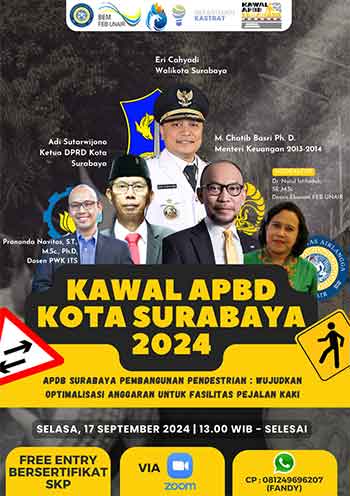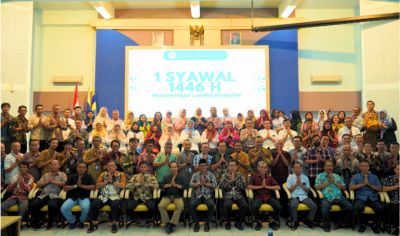 Monitoring the APBD is a discussion agenda between FEB UNAIR students, the general public and related agencies regarding the realization of the Surabaya APBD with an effort to once again promote a culture of discussion and increase public awareness and sensitivity towards the Surabaya APBD.
Monitoring the APBD is a discussion agenda between FEB UNAIR students, the general public and related agencies regarding the realization of the Surabaya APBD with an effort to once again promote a culture of discussion and increase public awareness and sensitivity towards the Surabaya APBD.
The APBD Monitoring Activity organized by FEB UNAIR students, the general public and related agencies has several connections with SDGs elements, namely:
1. SDG 16: Peace, Justice and Strong Institutions
● 16.3: Promoting an inclusive society for sustainable development, ensuring access for all people to justice, and building effective, accountable and inclusive institutions at all levels.
The APBD Monitoring activity encourages community participation in monitoring and evaluating the use of Surabaya APBD funds.
This is in line with the principles of good governance emphasized in SDG 16, namely transparency, accountability and public participation. 2. SDG 17: Partnership for the Goals
● 17.17: Strengthen the means of implementation and reinvigorate the global partnership for sustainable development.
APBD Monitoring activities involve various stakeholders, including students, the general public and related agencies.
This collaboration is a clear example of the multi-stakeholder partnership promoted in SDG 17. 3. SDG 11: Inclusive, Safe, Durable and Sustainable Cities and Human Settlements
● 11.6: Reduce the negative impact of cities on the environment, including by paying attention to waste management and atmospheric emissions, and promote inclusive, safe, durable and sustainable development of cities and human settlements.
Monitoring APBD activities can help ensure that APBD funds are used to support sustainable city development.
This can include investments in environmentally friendly infrastructure, inclusive public services, and safe and comfortable public spaces. 4. SDG 10: Reduce Inequalities within and between Countries
● 10.2: Empower and promote the social, economic and political inclusion of all people, including those who are marginalized, at all levels.
The Kawal APBD activity can help increase public awareness about how the APBD can be used to reduce inequality.
The discussions and dialogue held during this activity can encourage the government to design and implement policies that are fairer and more inclusive. 5. SDG 12: Responsible Consumption and Production
● 12.a: Implement the 10-Year National Action Plan to achieve SDG 12 targets on sustainable consumption and production.
The APBD Monitoring activity can encourage the government to prioritize the procurement of goods and services that are environmentally friendly and sustainable.
Apart from that, this activity can also increase public awareness about the importance of responsible consumption. Overall, the APBD Monitoring activity is a positive step that can contribute to achieving the SDGs.
By increasing community participation, transparency and accountability in APBD management, this activity can help create a more just, sustainable and prosperous city for all. Apart from the SDGs elements mentioned above, APBD Monitoring activities can also be linked to other SDGs elements, such as SDG 1 (Poverty Eradication), SDG 4 (Quality Education), and SDG 5 (Gender Equality).
It is important to note that the link between APBD Monitoring activities and SDGs elements can be interpreted in various ways. The points mentioned above are just a few examples of how these two things can be connected.

























